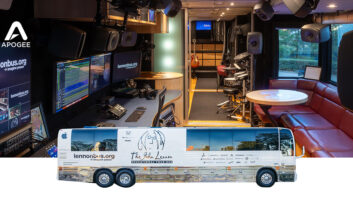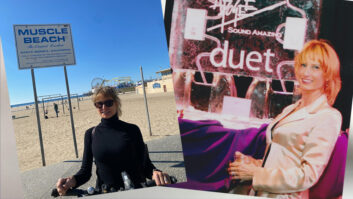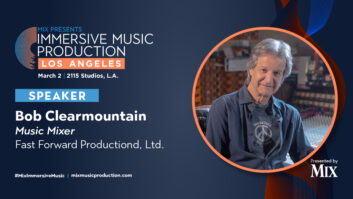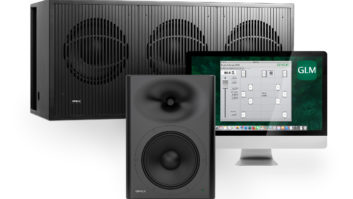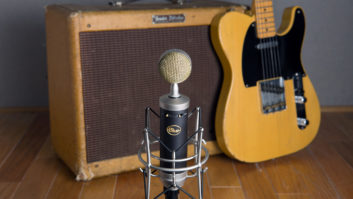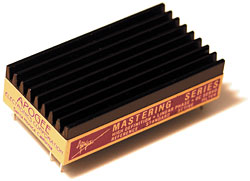
Pro audio has always had its share of boutique companies, many dealing with high-end analog products. In a world where technology is constantly changing, the survival of a small company specializing in digital products is unusual. However, Apogee Electronics is not your usual company.
Apogee made its debut with the 944 filters
The company began in 1985 with a conversation among three industry veterans: Bruce Jackson (now with Lake Technology), a top live sound engineer noted for his years of mixing Bruce Springsteen, Swiss digital designer Christof Heidelberger (now founder/CTO of BridgeCo) and Betty Bennett, then president of Soundcraft USA.
“At that time, CDs were just coming out and people were complaining about the way digital sounded — too clinical and metallic. It didn’t sound warm,” recalls Bennett, who now heads Apogee. “Bruce, Christof and I were talking about what the problem might be and realized it was the anti-aliasing filters. So Bruce and Christof started working on it.”
With the idea of marketing replacement anti-aliasing filters designed and manufactured by Heidelberg, Jackson and Bennett, they founded Apogee Electronics in December of 1985.
A year later, Apogee made its debut at the 1986 AES show in L.A. In a small, out-of-the-way booth, Jackson demonstrated the effect of Apogee’s 944 Series low-dispersion, linear phase active lowpass filters retrofitted into a few channels of a Sony PCM-3324 24-track digital machine. Using an oscilloscope, Jackson ran square waves into the deck. The waves that were routed through Apogee’s anti-aliasing filters looked like square waves; the waves coming from the 3324’s stock filters looked like watermelons. Clearly, something was very wrong with digital and very right with the 944s.
However, the filters weren’t exactly an instant success. “At first, we tried selling the filters on a strictly technical level and that didn’t work because the people who understood it weren’t in charge of the budget,” Bennett says. “Then we marketed it to the artists, who could hear the improvement and rapidly authorized the purchases. And it wasn’t cheap: It was about $5,000 for the filters to do a 3324. And the installation was complex — you had to desolder the original filters to install ours. You have to be pretty careful about going into somebody’s expensive machine, but we had a list of excellent techs we could refer people to.”
Apogee later expanded its list of recorders supported by its filter upgrades to include Mitsubishi and Otari ProDigi decks (both companies eventually OEM’ed the Apogee filters, installing them at the factory), as well as DAT machines and Sony’s PCM-F1 family of processors.
The upgrade market was fine, but there were a lot of customers who wanted a simpler solution for improving digital sound and something they could use wherever they wanted. So in 1991, Apogee released the AD500 and DA1000, its first outboard A/D and D/A converters. At the time, outboard converters for the pro market were hardly common, and as with the launch of the filters, Apogee was again involved in convincing the market on the benefit of its products.

Apogee co-founder Betty Bennett
“We’ve always used education to try to help people understand what we were doing,” says Bennett. “Better filters, converters, digital (UV22) and low-jitter clocks will make digital gear sound better, but we had to be really good at educating people to help them understand the benefits of replacing their converters. Otherwise, why would someone buy something that they already had built into their existing equipment?”
One distinctive part of Apogee gear is its look. “The idea for making purple gear came from Bruce,” Bennett recalls. “He has a good eye for design, and we wanted to distinguish ourselves from the all-black rack gear that everybody had at that point. Since then, there’s been a lot of purple stuff.” These days, some companies spend weeks on finalizing a logo, but that wasn’t the Apogee way: “The logo was designed by a Clair Bros. lighting designer,” Bennett adds. “One night at dinner, he drew it on a napkin and that was it.”
Not every Apogee effort was a huge success, such as marketing a line of tapes for Alesis ADATs and a brief foray into software, although MasterTools and SessionTools were successful. Apogee refocused on hardware and began to license their software to other companies. In hardware, the hits kept coming, garnering an impressive string of 11 TEC Awards for its 944 filters, AD-500 stereo A/D converter, UV-1000 mastering processor, AD-1000 ADC, FC-8 digital format converter, AD-8000 (Apogee’s first multichannel converter), Big Ben digital clock, and PSX-100, Trak 2, AD16 and Mini-Me converters
But with all its success, Apogee remains a small, tightly knit group of 25 employees, and Bennett likes to keep the company in perspective. “We’ve been very fortunate,” she says. “I’ve seen many companies come and go over the years — either disappearing or being bought. Staying independent has been good for us. Once you go public, your focus shifts slightly and you find yourself doing things that might not be good for the overall health of the company, like coming out with lesser products just to keep the stock price up. Apogee has the luxury of releasing products that we think will make a difference, regardless of shareholder pressures. Thankfully, we continue to do well in this regard. We have great people here and share the proceeds with them, because it’s the people at Apogee who make the company.
For more information, visit Apogee at AES at booth #526 or online at www.apogeedigital.com.
